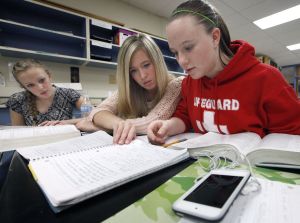On a typical school night, while most chemistry students are solving homework problems, Verona High School junior Alison Ford is watching her teacher lecture on her iPod Touch.
The next day in class she huddles with two classmates to work on equilibrium equations based on the recorded lecture while her teacher moves between groups of students to answer questions about the assignment.
"It's a lot nicer because instead of tying up class time trying to explain everything, it really allows you to learn at your own pace," Ford said.
Welcome to the "flipped classroom," a learning model that is going viral across Wisconsin and the nation. It's being employed not only in local elementary and high schools, but also at Madison Area Technical College, UW-Madison and even the Madison Fire Department.
The method is appealing for several reasons: it employs high-tech gadgets and online social networking popular among young people; students can pause and review parts of lectures they don't understand without stopping an entire class; and teachers can spend more classroom time on individualized instruction.
It also has some limitations, such as ensuring that low-income students have access to computers and the Internet. Some students accustomed to completing homework assignments without learning the material might resist. And the process of creating original videos can be time-consuming for teachers at first, but once created they can be reused and add to a growing online library of educational materials that teachers can share for free on websites such as YouTube.
The education institutions that develop curriculum and write textbooks also might resist the shift of learning material to the Internet, where quality and accuracy can be more questionable, said Richard Halverson, a UW-Madison education professor who studies school technology and new media.
But many students are already looking up information online and solving homework problems while texting with friends, an indication that the "flipped classroom" will soon be the regular classroom of the 21st century.
"It's catching on like crazy," Halverson said. "It has been a dream of many educators for a long time, to use your time with students to help them understand meaning rather than deliver information."
'Midwest really embracing this'
It's hard to gauge how many teachers in the country are using the flipped model, but the national Flipped Learning Network has seen participation in its online community more than quadruple in the past year, from 2,500 to about 11,000 today, executive director Kari Afrstrom said.
In Wisconsin, the Department of Public Instruction is strongly advocating for innovations such as the flipped classroom, spokesman John Johnson said. The state's Digital Learning Strategic Plan released a year ago called the flipped classroom a "low-cost idea that should be explored," but warned that it would only be possible if schools invested in digital resources.
Arfstrom said her organization has conducted six trainings in Wisconsin in the past six months, more than most other states. "The Midwest is really embracing this," she said.
Teachers using the flipped model report seeing improvements in student test scores, Arfstrom said, though no studies have been done to verify that.
Ann Moffat, a teacher for 29 years, including 19 in Verona, said she was originally skeptical about switching to the flipped classroom model. Her Socratic lecture style involves quizzing students as she writes out chemistry equations on the board; under the new model she records her lectures in five- to 12-minute snippets without an audience to react.
But it wasn't long before Moffat embraced the new method. Not only can she offer more individualized attention during class, but she also no longer has students seeking assistance before school starts.
The peer collaboration also simulates what they'll experience in the work world, Moffat said. "They're learning how to work off each other and solve problems independently, which is the whole goal."
Not limited to schools
Matt McLaughlin, a physics teacher at Sun Prairie High School who began converting to a flipped classroom last spring, said some students resisted the change.
"When I first started, they looked at this as, 'Oh, you mean I don't have any homework,'" McLaughlin said. At one point McLaughlin switched back to normal lectures, but found more students asking that he continue to provide the online lectures.
The model isn't limited to area high schools. Madison Area Technical College offers classes, such as robotics and dentistry, where instructors use online lectures to make more time for hands-on experience in the classroom.
Faculty instructors Tina Rettler-Pagel and Nancy Woodward are offering a class in April for MATC teachers to learn how to employ the flipped model.
"The flipped model speaks to so many types of students: the student who is busy, the student who is struggling with content," Rettler-Pagel said.
UW-Madison has set up two classrooms on campus where students can take business, engineering and math courses using the flipped model.
Chris Olsen, vice provost for teaching and learning, said the courses have proven so popular the university is looking to create more flipped classroom space.
"There is growing data from the higher education world that the flipped classroom approach is as efficacious as the traditional approach," Olsen said.
The Madison Fire Department has been training both new recruits and veteran firefighters with elements of the flipped model for more than a decade, assistant chief of operations Jim Keiken said.
By reviewing ahead of time a lesson about a high-rise fire or how to dismantle a car, trainees have more time for the hands-on component. They also are able to review the lecture at their own convenience, which can be especially important for firefighters who are constantly called into action and have limited time for sitting in class.
"Not only has it made them more available, it's made them better at the skills that we're looking to give someone," Keiken said.
